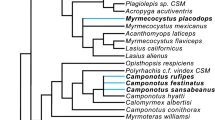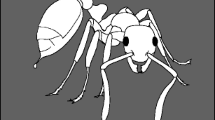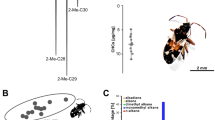Abstract
A new invader, the “tawny crazy ant”, Nylanderia fulva (Hymenoptera: Formicidae; Formicinae), is displacing the red imported fire ant, Solenopsis invicta (Formicidae: Myrmicinae), in the southern U.S., likely through its superior chemical arsenal and communication. Alone, formic acid is unattractive, but this venom (= poison) acid powerfully synergizes attraction of tawny crazy ants to volatiles from the Dufour’s gland secretion of N. fulva workers, including the two major components, undecane and 2-tridecanone. The unexpected pheromonal synergism between the Dufour’s gland and the venom gland appears to be another key factor, in addition to previously known defensive and detoxification semiochemical features, for the successful invasion and domination of N. fulva in the southern U.S. This synergism is an efficient mechanism enabling N. fulva workers to outcompete Solenopsis and other ant species for food and territory. From a practical standpoint, judicious point-source release formulation of tawny crazy ant volatiles may be pivotal for enhanced attract-and-kill management of this pest.



Similar content being viewed by others
References
Ali MF, Attygalle AB, Billen J, Morgan ED (1988) Contents of dufour glands in some formicine ants: queens and workers of Camponotus aethiops and a re-examination of Lasius fuliginosus. Entomol Exp Appl 46:109–115
Bergström G, Löfqvist J (1970) Chemical basis for odour communication in four species of Lasius ants. J Insect Physiol 16:2353–2375
Chen J, Rashid T, Feng G, Zhao L, Oi D, Drees B (2013) Defensive chemicals of tawny crazy ants, Nylanderia fulva (Hymenoptera: Formicidae) and their toxicity to red imported fire ants, Solenopsis invicta (Hymenoptera: Formicidae). Toxicon 76:160–166
Chen L, Mullen GE, Le Roch M, Cassity CG, Gouault N, Fadamiro HY, Barletta RE, O’Brien RA, Sykora RE, Stenson AC (2014) On the formation of a protic ionic liquid in nature. Angew Chem 126:11956–11959
Czaczkes TJ, Vollet-Neto A, Ratnieks FL (2013) Prey escorting behavior and possible convergent evolution of foraging recruitment mechanisms in an invasive ant. Behav Ecol
Deyrup M, Davis L, Cover S (2000) Exotic ants in Florida. Trans Am Entomol Soc 293–326
Fujiwara-Tsujii N, Yamagata N, Takeda T, Mizunami M, Yamaoka R (2006) Behavioral responses to the alarm pheromone of the ant Camponotus obscuripes (Hymenoptera: Formicidae). Zool Sci 23:353–358
Gotzek D, Brady SG, Kallal RJ, LaPolla JS (2012) The importance of using multiple approaches for identifying emerging invasive species: the case of the Rasberry crazy ant in the United States. PLoS One 7:e45314
Hillery AE, Fell RD (2000) Chemistry and behavioral significance of rectal and accessory gland contents in Camponotus pennsylvanicus (Hymenoptera: Formicidae). Ann Entomol Soc Am 93:1294–1299
Hölldobler B, Oldham N, Morgan E, König W (1995) Recruitment pheromones in the ants Aphaenogaster albisetosus and A. cockerelli (Hymenoptera: Formicidae). J Insect Physiol 41:739–744
Hölldobler B, Stanton RC, Markl H (1978) Recruitment and food-retrieving behavior in Novomessor (Formicidae, Hymenoptera). Behav Ecol Sociobiol 4:163–181
Hooper-Bui LM, Strecker R, Chen X, Aguillard D, Miller A (2010) Supercolonies of crazy ants in Louisiana. In: Hopkins JD (ed) Little Rock, Arkansas. pp 13–16
Kohl E, Hölldobler B, Bestmann H (2001) Trail and recruitment pheromones in Camponotus socius (Hymenoptera: Formicidae). Chemoecology 11:67–73
LeBrun EG, Abbott J, Gilbert LE (2013) Imported crazy ant displaces imported fire ant, reduces and homogenizes grassland ant and arthropod assemblages. Biol Invasions 1–14
LeBrun EG, Jones NT, Gilbert LE (2014) Chemical warfare among invaders: a detoxification interaction facilitates an ant invasion. Science 343:1014–1017
Lenz EL, Krasnec MO, Breed MD (2013) Identification of undecane as an alarm pheromone of the ant Formica argentea. J Insect Behav 26:101–108
Lloyd H, Blum M, Snelling R, Evans S (1989) Chemistry of mandibular and Dufour’s gland secretions of ants in genus Myrmecocystus. J Chem Ecol 15:2589–2599
MacGown J, Layton B (2010) The invasive Rasberry crazy ant, Nylanderia sp. near pubens (Hymenoptera: Formicidae), reported from Mississippi. Midsouth Entomol 3:44–47
McDonald DL (2012) Investigation of an invasive species: Nylanderia fulva colony extraction, management, diet preference, fecundity, and mechanical vector potential [PhD Thesis]. College Station: Texas A&M University. 150 p
Meyers JM (2008) Identification, distribution and control of an invasive pest ant, Paratrechina sp. (Hymenoptera: Formicidae), in Texas [PhD Thesis]. College Station: Texas A&M University. xiv + 162 p
Meyers JM, Gold RE (2008) Identification of an exotic pest ant, Paratrechina sp. nr. pubens (Hymenoptera: Formicidae), in Texas. Sociobiology 52:589–604
Morgan ED (2008) Chemical sorcery for sociality: Exocrine secretions of ants (Hymenoptera: Formicidae). Myrmecol News 11:79–90
Morgan ED, Jackson BD, Billen J (2005) Chemical Secretions of the “Crazy Ant” Paratrechina longicornis (Hymenoptera: Formicidae). Sociobiology 46:299–304
Regnier F, Wilson E (1968) The alarm-defence system of the ant Acanthomyops claviger. J Insect Physiol 14:955–970
Regnier F, Wilson EO (1969) The alarm-defence system of the ant Lasius alienus. J Insect Physiol 15:893–898
Schneidmiller RG, Zhang Q-H (2012) Method and dispenser for controlled release semiochemicals. US Patent application publication # 20120280055A1
Traniello JF (1983) Social organization and foraging success in Lasius neoniger (Hymenoptera: Formicidae): behavioral and ecological aspects of recruitment communication. Oecologia 59:94–100
Vinson SB (2013) Impact of the invasion of the imported fire ant. Insect Sci 20:439–455
Witte V, Abrell L, Attygalle AB, Wu X, Meinwald J (2007a) Structure and function of Dufour gland pheromones from the crazy ant Paratrechina longicornis. Chemoecology 17:63–69
Witte V, Attygalle AB, Meinwald J (2007b) Complex chemical communication in the crazy ant Paratrechina longicornis Latreille (Hymenoptera: Formicidae). Chemoecology 17:57–62
Zhang Q-H, Schneidmiller RG, Chapin M (2013) Traps for crawling pests. US Patent application publication # 20130318860A1
Zhao L, Chen J, Jones WA, Oi DH, Drees BM (2012) Molecular comparisons suggest Caribbean crazy ant from Florida and Rasberry crazy ant from Texas (Hymenoptera: Formicidae: Nylanderia) are the same species. Environ Entomol 41:1008–1018
Acknowledgments
We thank Neil Michaelson, Dave Bearden, Guiji Zhou, Armen Margaryan and Dewey Welshons for assistance in trap and dispenser preparations, and Dr. Fudd Graham (Auburn University) on the occurrence of N. fulva in Alabama. Q-HZ and RGS are listed as inventors on a partially related US patent application submitted by Sterling International, Inc.
Author information
Authors and Affiliations
Corresponding author
Rights and permissions
About this article
Cite this article
Zhang, QH., McDonald, D.L., Hoover, D.R. et al. North American Invasion of the Tawny Crazy Ant (Nylanderia fulva) Is Enabled by Pheromonal Synergism from Two Separate Glands. J Chem Ecol 41, 853–858 (2015). https://doi.org/10.1007/s10886-015-0622-6
Received:
Revised:
Accepted:
Published:
Issue Date:
DOI: https://doi.org/10.1007/s10886-015-0622-6




